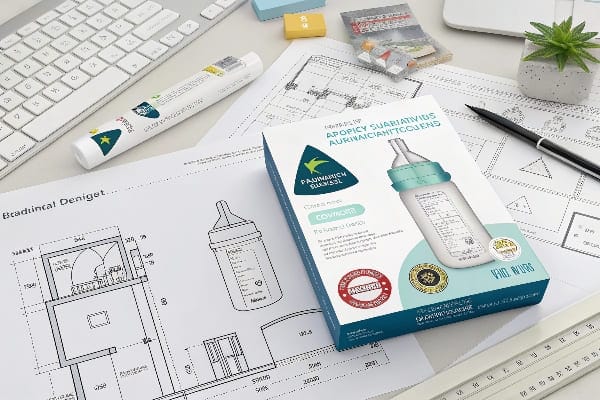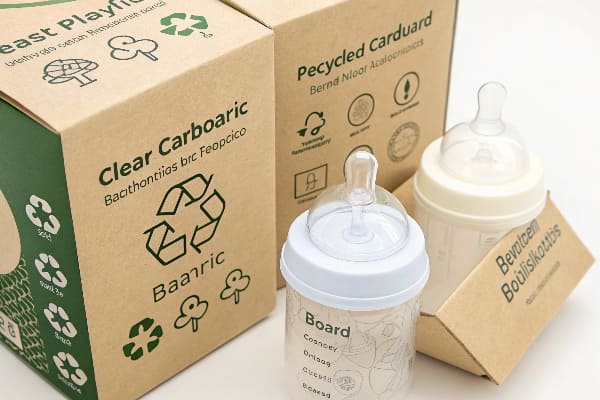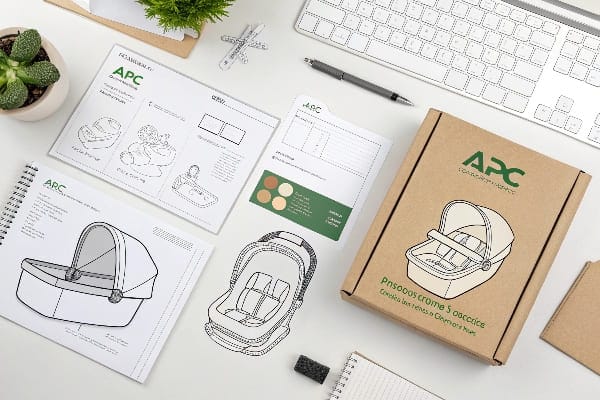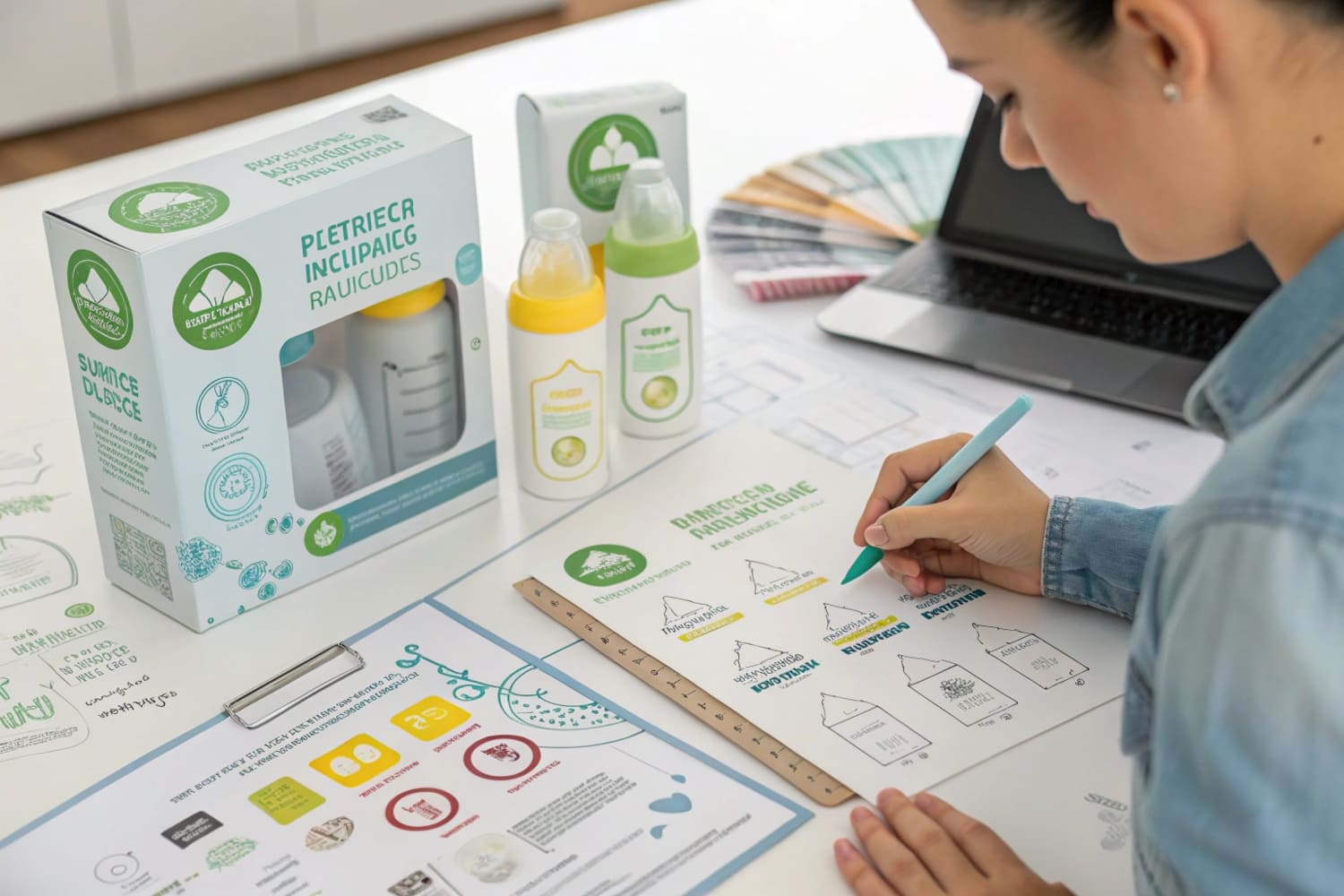I face tight launch dates and strict safety rules. I use clear checklists and fast sampling to keep baby product displays compliant and on time.
In the US, I follow CPSIA tracking labels, CPSC hazard warnings, ASTM toy rules, and PPPA child-resistant packaging where needed. In Australia, I apply APCO's Sustainable Packaging Guidelines and follow ACL truth-in-labelling rules, with ARL disposal labels where appropriate.

I will map the exact rules that matter. I will show quick wins for cardboard displays. I will add my field notes, so you can avoid delays and rework.
What are the sustainable packaging guidelines for Australian packaging covenant?
I design for less waste first. I choose mono-materials, water-based inks, and clear disposal instructions. My team tests strength, foldability, and print legibility on every sample.
APCO's Sustainable Packaging Guidelines (SPGs) ask me to reduce materials, design for reuse and recycling, increase recycled content, avoid hazardous substances, optimise logistics, and give clear disposal instructions like the ARL, while balancing product protection and cost.

How I apply APCO SPGs on cardboard displays
I work to the ten APCO Sustainable Packaging Principles1. They cover reduction, reuse, recyclability, recycled content, consumer information, supply-chain impacts, transportation efficiency, and closed-loop outcomes. I use these to drive each design review. I check corrugate grade, flute profile, and print process against performance and recovery. I also map where the display will stand. A Costco pallet needs different strength and print durability than a boutique counter unit. I add the Australasian Recycling Label2 (ARL) when the customer allows, because it helps shoppers dispose of each component. I keep claims simple and true under the Australian Consumer Law. My rule is this: if I cannot prove it in writing, I do not print it. This protects your brand and speeds approvals with retail partners and customs. For background, APCO's SPGs and principle documents explain these expectations and link them to Australia's 2025 circular targets.
| SPG focus | What I do on cardboard | Why it matters |
|---|---|---|
| Reduce material | Right-size panels; remove foam | Cuts cost and waste |
| Design for recycling3 | Mono-material corrugate; peelable labels | Improves recovery rates |
| Recycled content | Specify PCR liner where print allows | Lowers footprint |
| Safe inks/adhesives4 | Water-based inks; low-VOC glue | Safer conversion and end-of-life |
| Clear disposal info | Add ARL (Check Locally / Kerbside) | Guides consumers |
Which Australian law regulates what Australian businesses can put on their packaging?
I treat every claim on pack like a promise. I only print claims that I can prove with data and lab reports.
The Australian Consumer Law (ACL) bans false or misleading packaging claims, including "green" claims. Packaging stewardship sits under the NEPM for Used Packaging Materials, co-regulated with APCO, and states can enforce compliance for liable brand owners.

What the ACL and NEPM mean for my artwork and substrates
The ACL is Schedule 2 of the Competition and Consumer Act 2010. It requires accurate, truthful, and substantiated on-pack statements. The ACCC's greenwashing guidance5 explains how to substantiate recyclability or recycled-content claims. I follow it when I prepare marketing copy, icons, and ARL instructions. The national co-regulatory framework for packaging is the National Environment Protection (Used Packaging Materials) Measure 2011 (NEPM)6. Businesses that meet "brand owner" tests and pass the $5 million turnover threshold must either join APCO and report, or face direct state regulation and audits. State EPAs can investigate and fine for non-compliance. I plan artwork and claims with this in mind. I avoid vague phrases like "eco-friendly." I use specific, provable lines like "carton is recyclable in kerbside" or "contains 30% recycled fibre," backed by invoices and mill certs. Recent ACCC actions show how costly loose claims can be.
| Topic | Practical takeaway |
|---|---|
| ACL truth-in-labelling | Substantiate every claim before print. |
| Green claims7 | Use ACCC guidance; avoid vague terms. |
| NEPM & APCO | Choose APCO membership or state regulation if liable. |
| ARL label8 | Use where possible to guide disposal. |
What are the sustainable packaging concepts?
I start with the simple waste hierarchy. I avoid first. I reduce next. I reuse where I can. I design for recycling at the end.
Core concepts are: avoid and reduce materials, design for reuse, design for recycling or composting, increase recycled content, eliminate hazardous substances, make claims you can prove, and provide clear disposal instructions.

Concepts I use on real baby-product displays
I keep structural design simple. Fewer parts mean less waste and faster setup. I pick mono-material corrugate with printable liners. I use water-based inks and low-VOC adhesives. I specify PCR content only when print quality stays sharp. I add QR codes for digital manuals, so I remove extra leaflets. I include ARL panels with component-level guidance. I design for flat-pack shipping to cut freight emissions and damage. In the US, I make sure sustainability9 does not fight safety rules. I keep CPSIA tracking labels10 visible on the product and its packaging. I keep any hazard warnings clear and separate. For baby toys, I follow ASTM F963 and CPSC small-parts labelling. For pacifiers and rattles, I follow the specific 16 CFR parts. I never put claims that confuse safety with sustainability. Safe first, then green. This approach works across US and Australia without redesign between regions.
| Concept | US check | AU check |
|---|---|---|
| Reduced material | Keep strength, drop excess board | Check SPGs "reduce" principle |
| Reuse11 | Knock-down, re-use hardware | Encourage reuse in SPGs |
| Recyclability12 | Mono-material; remove foils | Match ARL instructions |
| Recycled content | Verify PCR with supplier docs | Claim only what you can prove |
| Safe + compliant | CPSIA, ASTM, CPSC labels | ACL truth-in-labelling |
I once supported a baby-care launch with 1,500 counter displays. My early prototypes failed edge-crush tests after we reduced flute weight. I switched to a higher-ECT single-wall spec13 and moved a stress notch by 8 mm. I kept the box count unchanged, but I removed a plastic clip and added a fold-lock. I printed ARL and a clear "kerbside" note for Australia. I kept the US side free for the CPSIA tracking label14 and a small-parts warning tag. The customer hit the shelf date. The waste dropped by 12%. The reorders came faster.
Is the Australian packaging covenant mandatory?
I treat it as mandatory, because the threshold captures most serious brands.
If your Australian turnover is at least $5 million and you are a "brand owner," you have legal obligations under the NEPM co-regulatory framework. You must either join APCO and report, or be directly regulated by state or territory authorities.

What "mandatory" looks like in practice
Australia runs a co-regulatory scheme. The NEPM15 sets the legal backbone. APCO16 administers the industry pathway. If you are a liable brand owner with annual turnover of $5 million or more, you must meet obligations. You can meet them by becoming an APCO signatory and reporting against the SPGs. Or you can accept direct regulation by the states. State EPAs can audit and fine for non-compliance. Government pages, APCO guidance, and even a Senate committee summary confirm this structure and threshold. I advise clients to join APCO because it streamlines reporting, aligns design reviews with SPGs, and reduces duplication. My artwork checklists include "APCO/NEPM liability check" on page one. That keeps procurement, marketing, and legal on the same page before we lock print.
| Question | Short answer | Source |
|---|---|---|
| Is there a threshold17? | Yes, ≥ A$5 million turnover | |
| Do I have a choice? | APCO signatory18 or direct state regulation | |
| Who enforces? | State and territory EPAs | |
| What to follow? | SPGs + truthful claims under ACL |
Conclusion
Use safety rules first, then apply SPGs and ACL. Keep claims provable, labels clear, and structures simple. This speeds approvals and cuts waste across US and Australia.
Understanding these principles can enhance your packaging strategies and align with sustainability goals. ↩
Exploring the ARL can help improve consumer awareness and promote responsible disposal of packaging. ↩
Explore this link to understand how designing for recycling can enhance sustainability and improve recovery rates. ↩
Learn about safe inks and adhesives to ensure environmentally friendly packaging solutions that are safer for consumers. ↩
Exploring the ACCC's greenwashing guidance helps you create truthful marketing claims, avoiding costly penalties. ↩
Understanding NEPM is crucial for compliance in packaging regulations, ensuring your artwork meets legal standards. ↩
Understanding ACCC guidelines can help you make credible green claims, enhancing your brand's trustworthiness. ↩
Exploring the ARL label can provide insights on proper disposal methods, promoting sustainability and compliance. ↩
Explore this link to understand how sustainability can be effectively integrated into baby product design, ensuring safety and environmental responsibility. ↩
Learn about CPSIA tracking labels to ensure compliance and safety in baby products, which is crucial for manufacturers and consumers alike. ↩
Exploring this link will provide insights into effective strategies for promoting reuse, enhancing sustainability. ↩
This resource will guide you on achieving better recyclability, crucial for eco-friendly product design. ↩
Understanding higher-ECT single-wall specs can enhance your packaging knowledge and improve product durability. ↩
Exploring CPSIA tracking labels will help you ensure compliance and safety in your product packaging. ↩
Learn about NEPM's significance in environmental regulation and how it impacts businesses in Australia. ↩
Explore this link to understand APCO's role in Australia's co-regulatory scheme and its benefits for businesses. ↩
Understanding the turnover threshold is crucial for compliance and strategic planning in business. ↩
Exploring the role of APCO signatories can provide insights into sustainability practices and regulatory compliance. ↩




